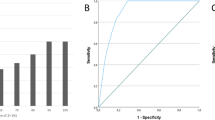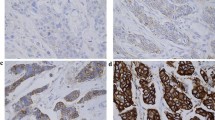Abstract
Accurate evaluation of human epidermal growth factor receptor 2 (HER2) status is quite crucial for invasive breast tumor patients in order to select anti-HER2 therapy for effective clinical outcomes. Immunohistochemistry (IHC) assay is routinely used to evaluate the HER2 oncoprotein overexpression but is unable to explain the chromosomal and genetic alterations and has been considered as a hot issue in IHC-equivocal cases. We investigated these molecular aberrations in correlation with prognostic factors. A cohort of 154 IHC-equivocal (+2) cases was selected and retrospectively analyzed by dual-probe fluorescence in situ hybridization (FISH) assay by using locus-specific HER2 and centromere enumeration probes (CEP17) for the identification of HER2 proto-oncogene amplification and chromosomal copy number per cell, respectively. The data were analyzed by SPSS 16.0 version using chi-square test (p < 0.05). We identified 36 out of 154 cases (23.4 %) showing HER2 gene amplification (average HER2 gene copies per cell >4 or <4 with HER2/CEP17 ratio >2) in concordance with HER2 oncoprotein overexpression, and significant correlation was observed with prognostic parameters including histological type, tumor grade II to III, histology and pathological type, lymphatic invasion, ductal carcinoma in situ (DCIS), and estrogen-positive and progesterone-negative receptors. Of the 154 cases, 18 cases (11.7 %) showed polysomy 17 with CEP17 probe signals per cell ≥3 and 22 cases (14.3 %) presented monosomy 17 (CEP17 probe signals per cell ≤1). Our data indicate that the use of anti-HER2 therapy should not be suggested unless true evaluation of HER2 protein expression is made regarding gene amplification essentially in IHC-ambiguous invasive breast tumors.

Similar content being viewed by others
References
Annual-Cancer-Registry-Report. Lahore: Shaukat Khanum Memorial Cancer Hospital and Research Centre, Lahore, Pakistan, (CRCDM) CRaCDM;2012.
Li CI, Uribe DJ, Daling JR. Clinical characteristics of different histologic types of breast cancer. Br J Cancer. 2005;93(9):1046–52.
Montemurro F, Cosimo SD, Arpino G. Human epidermal growth factor receptor 2 (HER2)-positive and hormone receptor-positive breast cancer: new insights into molecular interactions and clinical implications. Ann Oncol. 2013;24:2715–24.
Han X, Shi Y, Ma L, Lyu Z, Yang H, Yao J, et al. Comparison of immunohistochemistry with fluorescence in situ hybridization in determining the human epidermal growth factor receptor 2 status of breast cancer specimens: a multicenter study of 3,149 Chinese patients. Chin Med J Engl. 2014;127(2):246–53.
Dang HZ, Yu Y, Jiao SC. Prognosis of HER2 over-expressing gastric cancer patients with liver metastasis. World J Gastroenterol. 2012;18(19):2402–7.
Yarden Y, Sliwkowski MX. Untangling the ErbB signalling network. Nat Rev Mol Cell Biol. 2001;2(2):127–37.
Revillion F, Bonneterre J, Peyrat JP. ERBB2 oncogene in human breast cancer and its clinical significance. Eur J Cancer. 1998;34(6):791–808.
Takashima T, Nakayama T, Yoshidome K, Kawajiri H, Kamigaki S, Tsurutani J, et al. Phase II Study of S-1 in combination with trastuzumab for HER2-positive metastatic breast cancer. Anticancer Res. 2014;34:3583–8.
Hurvitz SA, Dirix L, Kocsis J, Bianchi GV, Lu J, Vinholes J, et al. Phase II randomized study of trastuzumab emtansine versus trastuzumab plus docetaxel in patients with human epidermal growth factor receptor 2-positive metastatic breast cancer. J Clin Oncol. 2013;31(9):1157–63.
Jackisch C. HER-2-positive metastatic breast cancer: optimizing trastuzumab-based therapy. Oncologist. 2006;11 Suppl 1:34–41.
Vogel CL, Cobleigh MA, Tripathy D, Gutheil JC, Harris LN, Fehrenbacher L, et al. Efficacy and safety of trastuzumab as a single agent in first-line treatment of HER2-overexpressing metastatic breast cancer. J Clin Oncol. 2002;20(3):719–26.
Wolff AC, Hammond ME, Hicks DG, Dowsett M, McShane LM, Allison KH, et al. Recommendations for human epidermal growth factor receptor 2 testing in breast cancer: American Society of Clinical Oncology/College of American Pathologists clinical practice guideline update. J Clin Oncol. 2013;31(31):3997–4013.
Orsaria M, Khelifa S, Buza N, Kamath A, Hui P. Chromosome 17 polysomy: correlation with histological parameters and HER2NEU gene amplification. J Clin Pathol. 2013;66(12):1070–5.
Couturier J, Vincent-Salomon A, Nicolas A, Beuzeboc P, Mouret E, Zafrani B, et al. Strong correlation between results of fluorescent in situ hybridization and immunohistochemistry for the assessment of the ERBB2 (HER-2/neu) gene status in breast carcinoma. Mod Pathol. 2000;13(11):1238–43.
Panjwani P, Epari S, Karpate A, Shirsat H, Rajsekharan P, Basak R, et al. Assessment of HER-2/neu status in breast cancer using fluorescence in situ hybridization and immunohistochemistry: experience of a tertiary cancer referral centre in India. Indian J Med Res. 2010;132:287–94.
Perez EA, Suman VJ, Davidson NE, Martino S, Kaufman PA, Lingle WL, et al. HER2 testing by local, central, and reference laboratories in specimens from the north central cancer treatment group N9831 intergroup adjuvant trial. J Clin Oncol. 2006;24(19):3032–8.
Wolff AC, Hammond ME, Schwartz JN, Hagerty KL, Allred DC, Cote RJ, et al. American Society of Clinical Oncology/College of American Pathologists guideline recommendations for human epidermal growth factor receptor 2 testing in breast cancer. J Clin Oncol. 2007;25(1):118–45.
Goud KI, Dayakar S, Vijayalaxmi K, Babu SJ, Reddy PV. Evaluation of HER-2/neu status in breast cancer specimens using immunohistochemistry (IHC) & fluorescence in-situ hybridization (FISH) assay. Indian J Med Res. 2012;135:312–7.
Wang S, Hossein Saboorian M, Frenkel EP, Haley BB, Siddiqui MT, Gokaslan S, et al. Aneusomy 17 in breast cancer: its role in HER-2/neu protein expression and implication for clinical assessment of HER-2/neu status. Mod Pathol. 2002;15(2):137–45.
Tubbs RR, Pettay JD, Roche PC, Stoler MH, Jenkins RB, Grogan TM. Discrepancies in clinical laboratory testing of eligibility for trastuzumab therapy: apparent immunohistochemical false-positives do not get the message. J Clin Oncol. 2001;19(10):2714–21.
Pauletti G, Dandekar S, Rong H, Ramos L, Peng H, Seshadri R, et al. Assessment of methods for tissue-based detection of the HER-2/neu alteration in human breast cancer: a direct comparison of fluorescence in situ hybridization and immunohistochemistry. J Clin Oncol. 2000;18(21):3651–64.
Huang HJ, Neven P, Drijkoningen M, Paridaens R, Wildiers H, Van Limbergen E, et al. Hormone receptors do not predict the HER2/neu status in all age groups of women with an operable breast cancer. Ann Oncol. 2005;16(11):1755–61.
Prati R, Apple SK, He J, Gornbein JA, Chang HR. Histopathologic characteristics predicting HER-2/neu amplification in breast cancer. Breast J. 2005;11(6):433–9.
Massarweh S, Schiff R. Resistance to endocrine therapy in breast cancer: exploiting estrogen receptor/growth factor signaling crosstalk. Endocr Relat Cancer. 2006;13 Suppl 1:S15–24.
Crowe JP, Patrick RJ, Rybicki LA, Escobar PF, Weng D, Thomas Budd G, et al. A data model to predict HER2 status in breast cancer based on the clinical and pathologic profiles of a large patient population at a single institution. Breast. 2006;15(6):728–35.
Author information
Authors and Affiliations
Corresponding author
Additional information
An erratum to this article is available at http://dx.doi.org/10.1007/s13277-016-5419-x.
Rights and permissions
About this article
Cite this article
Afzal, M., Amir, M., Hassan, M.J. et al. Clinical role of HER2 gene amplification and chromosome 17: a study on 154 IHC-equivocal cases of invasive breast carcinoma patients. Tumor Biol. 37, 8665–8672 (2016). https://doi.org/10.1007/s13277-015-4657-7
Received:
Accepted:
Published:
Issue Date:
DOI: https://doi.org/10.1007/s13277-015-4657-7




